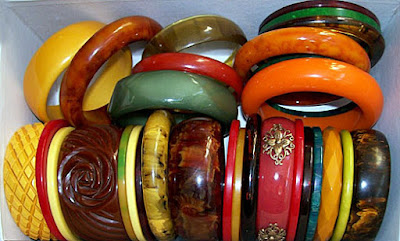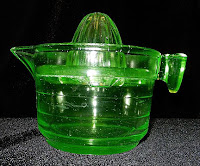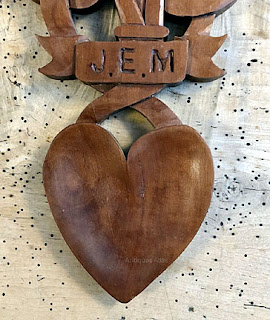
 ANSWER: Without knowing it, you’ve discovered a treasure of the early 20th century. Bakelite was a chemical miracle of the 20th century. It enabled manufacturers to make a variety of items—children’s toys, kitchenware, pipe stems, wall switches, appliance and cutlery handles, colorful radio cases, and yes, jewelry. Dubbed the “Material of a Thousand Uses” by the Bakelite Corporation, Bakelite was versatile and nonflammable.
ANSWER: Without knowing it, you’ve discovered a treasure of the early 20th century. Bakelite was a chemical miracle of the 20th century. It enabled manufacturers to make a variety of items—children’s toys, kitchenware, pipe stems, wall switches, appliance and cutlery handles, colorful radio cases, and yes, jewelry. Dubbed the “Material of a Thousand Uses” by the Bakelite Corporation, Bakelite was versatile and nonflammable.
 Leo Baekeland developed this innovative form of plastic in his backyard laboratory in Yonkers, New York, between 1907 and 1909. He attempted to create a synthetic shellac when he discovered that phenol, or carbolic acid, and formaldehyde, when combined under certain conditions, resulted in a molasses-colored resin with unique and exceptional properties.
Leo Baekeland developed this innovative form of plastic in his backyard laboratory in Yonkers, New York, between 1907 and 1909. He attempted to create a synthetic shellac when he discovered that phenol, or carbolic acid, and formaldehyde, when combined under certain conditions, resulted in a molasses-colored resin with unique and exceptional properties.
Once cured, the phenol formaldehyde resin could be ground into powder and mixed with a variety of fillers to create a molding compound that was practically indestructible. Slate dust, asbestos, wood flour and ground walnut shells were all used for this purpose, but because of their dark color, molded Bakelite was limited to shades of black, maroon and brown.
 In1911, he founded the General Bakelite Company in Perth Amboy, New Jersey, which produced up to 200,000 tons of the plastic each year. Because it was resistant to heat, moisture, and chemicals, it became a component of the electrical industry. It also had excellent insulating properties, making it perfect for use in electrical insulators, switches, plugs and sockets.
In1911, he founded the General Bakelite Company in Perth Amboy, New Jersey, which produced up to 200,000 tons of the plastic each year. Because it was resistant to heat, moisture, and chemicals, it became a component of the electrical industry. It also had excellent insulating properties, making it perfect for use in electrical insulators, switches, plugs and sockets.
Making Bakelite was a multi-stage process. It began with the heating of phenol and formaldehyde in the presence of a catalyst such as hydrochloric acid, zinc chloride, or the base ammonia. This created a liquid condensation product, referred to as Bakelite A, which was soluble in alcohol, acetone, or additional phenol. Heated further, the product became partially soluble and could still be softened by heat. Sustained heating resulted in an "insoluble hard gum."
 However, the high temperatures required to create this tended to cause violent foaming of the mixture when performed at standard atmospheric pressure, which resulted in the cooled material being porous and breakable. Baekeland's innovative step was to put his "last condensation product" into an egg-shaped "Bakelizer." By heating it under pressure at around 300° F, he was able to suppress the foaming. The resulting substance was extremely hard and both infusible and insoluble. The range of colors available included black, brown, red, yellow, green, gray, blue, and blends of two or more of these.
However, the high temperatures required to create this tended to cause violent foaming of the mixture when performed at standard atmospheric pressure, which resulted in the cooled material being porous and breakable. Baekeland's innovative step was to put his "last condensation product" into an egg-shaped "Bakelizer." By heating it under pressure at around 300° F, he was able to suppress the foaming. The resulting substance was extremely hard and both infusible and insoluble. The range of colors available included black, brown, red, yellow, green, gray, blue, and blends of two or more of these.
 Bakelite came in various forms to suit varying needs, including clear material, for jewelry and smokers' articles, cement, used in sealing electric light bulbs in metal bases, varnishes, for impregnating electric coils, lacquers, for protecting the surface of hardware, and enamels, for giving resistive coating to industrial equipment. In addition, there was laminated Bakelite, used for silent gears and insulation; and molding material, used to form items of utility and beauty.
Bakelite came in various forms to suit varying needs, including clear material, for jewelry and smokers' articles, cement, used in sealing electric light bulbs in metal bases, varnishes, for impregnating electric coils, lacquers, for protecting the surface of hardware, and enamels, for giving resistive coating to industrial equipment. In addition, there was laminated Bakelite, used for silent gears and insulation; and molding material, used to form items of utility and beauty.
When Bakelite’s patent on phenol formaldehyde expired in 1927, other companies using the chemical came on the scene, including the American Catalin Corporation which pioneered a purified form of phenolic resin that did away with the dense fillers used in molded Bakelite. The company introduced casting resins in 20 different colors.
 The Bakelite Corporation quickly developed its own phenolic resin, producing it in thousands of colors. In reality its recipes were exactly the same as American Catalin, except they experimented more with dye saturation and mixing colorants with clear resin to create mottled and swirled effects.
The Bakelite Corporation quickly developed its own phenolic resin, producing it in thousands of colors. In reality its recipes were exactly the same as American Catalin, except they experimented more with dye saturation and mixing colorants with clear resin to create mottled and swirled effects.
By the mid 1930s, several competitors had begun producing phenolics which forced the price of both Bakelite and Catalin down. One of these other companies, Fiberloid, introduced Opalon in lapis lazuli, mottled red, alabaster, onyx and mottled walnut, fabricated into board game pieces, jewelry, and umbrella and knife handles.
 The introduction of electrical power gave rise to a wide range of labor-saving devices that utilized Bakelite and Catalin in one way or another. The modern appearance, durability and hygienic qualities of plastic made it superior to traditional substances.
The introduction of electrical power gave rise to a wide range of labor-saving devices that utilized Bakelite and Catalin in one way or another. The modern appearance, durability and hygienic qualities of plastic made it superior to traditional substances.
Bakelite quickly replaced wood and metal in telephones, clock and barometer cases, as well as knobs and handles on small appliances like electric irons, toasters and cookware. Colorful Catalin cutlery handles and novelty napkin rings dressed up the table and brightened the kitchen.
In 1933 the Bakelite Corporation began to produce wood-tone radio cabinets of compression-molded phenolic resin. Thermosetting plastics resisted the heat generated by radio tubes, making Catalin ideal for radio cabinets. It wasn't long before colorful, modernistic Catalin radios began to make their appearance.
 By 1936, various companies made two-thirds of all costume jewelry produced in the U.S. by fabricated molding and fabricating cast phenolic resin. The fabricating process, however, was labor-intensive and lengthy.
By 1936, various companies made two-thirds of all costume jewelry produced in the U.S. by fabricated molding and fabricating cast phenolic resin. The fabricating process, however, was labor-intensive and lengthy.
First, molds had to be made by dipping a steel master into molten lead. Once workers assembled enough molds, others prepared phenolic resin and carefully poured it into each mold by hand. A technician carefully combined resins as casting occurred if special swirled or mottled colors were desired, the technician needed to carefully combine resins as they were being cast.
 Once filled, workers wheeled the molds into a huge oven to be baked at176 degrees F. until the resin cured. Curing time varied. Dark red and blue cured in three to four days while whites took six to eight days. Once the cast resin cured, workers removed it from the lead molds using air hammers. This always resulted in damaged molds. Other workers tossed the broken pieces back into the vat of molten lead to be melted down for reuse.
Once filled, workers wheeled the molds into a huge oven to be baked at176 degrees F. until the resin cured. Curing time varied. Dark red and blue cured in three to four days while whites took six to eight days. Once the cast resin cured, workers removed it from the lead molds using air hammers. This always resulted in damaged molds. Other workers tossed the broken pieces back into the vat of molten lead to be melted down for reuse.
To make jewelry components, workers cut shaped or hollow phenolic rods into individual pieces, much like slicing a loaf of bread. Then they carved and machined by hand them for added adornment. Once they completed the decorative carving, they finished the pieces by tumbling or buffing on a polishing wheel.
 Bakelite became a symbol of progress and modernity as the streamlined Art Moderne style overtook the chic style of Art Deco. The sharp-stepped sides of skyscrapers softened into curves, while boxy trains and automobiles became sleek, with fluid lines that created the illusion of speed and motion.
Bakelite became a symbol of progress and modernity as the streamlined Art Moderne style overtook the chic style of Art Deco. The sharp-stepped sides of skyscrapers softened into curves, while boxy trains and automobiles became sleek, with fluid lines that created the illusion of speed and motion.
By the late 1930s, plastic moldings reflected the streamline design trends. Shiny surfaces, modernistic curves, waterfall fronts and facades, made to look like car grills, all found their way into jewelry, small home appliances and decorative household objects.
 Perfectly suited to Bakelite and Catalin molds, the Art Moderne style enabled the resin to easily flow inside a curved mold. In addition, it was easier to mold, fabricate, and polish the resulting casts than the boxy, stepped sides and sharp corners of Art Deco designs.
Perfectly suited to Bakelite and Catalin molds, the Art Moderne style enabled the resin to easily flow inside a curved mold. In addition, it was easier to mold, fabricate, and polish the resulting casts than the boxy, stepped sides and sharp corners of Art Deco designs.
Cast phenolic resins weren’t as durable as compression molded phenolic compounds because they shrank over time, often resulting in cracks. Catalin averaged a 4 percent shrinkage in the first 10 years. Cracks developed in radio cases because the parts were bolted to the housing, leading to stress as the plastic shrank.
Though companies produced Catalin in 20 opaque and translucent colors, engineers limited the color range because they felt all other dyes would cause instability in the plastic.
Unfortunately, Catalin reacted to ultraviolet light by converting to phenyl alcohol, which was brownish in color. That was why so many Catalin items are amber colored. The effect turned original white to butterscotch, bright blue into drab olive, green into butterscotch, and brilliant red marble into brown.
To read more articles on antiques, please visit the Antiques Articles section of my Web site. And to stay up to the minute on antiques and collectibles, please join the over 30,000 readers by following my free online magazine, #TheAntiquesAlmanac. Learn more about "folk art" in the 2023 Winter Edition, online now. And to read daily posts about unique objects from the past and their histories, like the #Antiques and More Collection on Facebook.








































